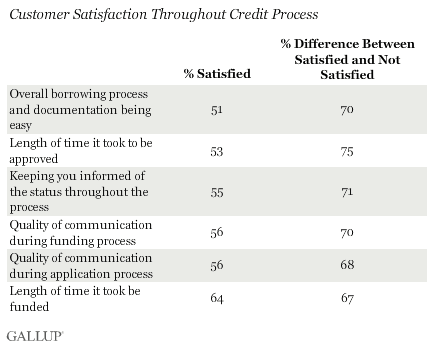This post is part of Gallup's ongoing series on the shifting landscape for financial institutions. It provides insights into channel optimization, emerging customer behaviors and preferences, product penetration and relationship growth, engaging the most critical affluent and business customers, and reshaping banks' overall value proposition.
Banks are more likely to drive engagement with their business banking clients when they can effectively meet their clients' credit needs. But giving the green light on a loan application or line of credit doesn't tell the whole story of engagement -- clients also expect great service. In our 2013 Business Banking Industry survey, Gallup found that merely 56% of businesses who were approved for credit said they were satisfied with the overall process of obtaining a business loan or line of credit.
When we looked at the individual aspects of the credit process, we found that approval times and communication were the two biggest differentiators between businesses that were satisfied and those that were not with the overall credit approval process. Not surprisingly, there was greater satisfaction at the funding stage than the application stage.

At most of the banks I've spoken to, the application process for securing loans and lines of credit is unexpectedly complex and often unwieldy for customers. Yes, underwriting guidelines and compliance issues must be adhered to, but the systems, processes, and communications around them must be clear and transparent to customers.
Banks can better engage customers through a more intentional focus on communication and service by:
1. Over-explaining the "why" and the "how." Naturally, your customers are going to have questions as they go through the application and approval process, such as:
- Why does this take so long?
- Why is this information needed to make the decision?
- Why is this information not relevant to the decision?
- If I am turned down, why and how can I ensure that doesn't happen next time?
In every communication -- written and verbal -- and at every step of the process, be sure to proactively explain the "why" and the "how" to your clients. You can go a long way in easing their anxiety and building trust just by taking the time to talk through their questions and concerns.
2. Setting clear and honest expectations upfront. Don't tell a customer that they will receive a decision in 30 days, when in reality, you know it's going to be more like 60 days. Instead, give them a date range (30-60 days) and don't promise something you can't deliver. Let the customer know that the clock doesn't officially start ticking on a decision until you receive and accept their complete application. Honesty really is the best policy -- don't set yourself up for future failure and disappointment from the initial meeting by being unrealistic.
3. Presenting a united front. Throughout the application and approval process, clients will most likely be introduced to different employees within the bank. They should receive consistent service and the same answers from every employee. Be sure to:
- Keep a written record (in official systems or otherwise) of all client contact during the process, so that no team member is out of the loop. The client may also be a large, personal customer of the bank as well, therefore you should also include their personal banking relationship manager in your communication.
- Internally, set clear expectations as to who owns what parts of the customer communication process.
- Ensure the content of all communications are client centric and not bank centric -- no bank jargon or acronyms.
- Err on the side of communicating too often, rather than not enough.
